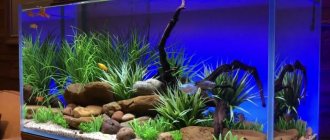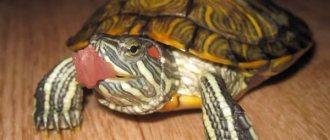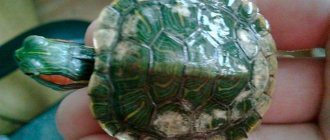There are many reptile lamps sold in pet stores today, but not all of them may be equally beneficial for your pets.
Moreover, the same lamp will demonstrate different efficiency under different conditions. When purchasing individual types, you will simply throw money away without getting the desired result.
So how do you choose the most useful lamp for your turtle and are they really necessary? Let's figure it out.
Features of keeping turtles
Under natural conditions, these creatures bask in the sun, receiving everything they need from their rays.
A sunbeam is a very rich spectrum in its components.
At home, you will have to recreate a similar microclimate for the full development and growth of the reptile. Therefore, at home they are placed in special aquariums or terrariums.
If your pet is a waterfowl, then you will have to make sure that the aquarium contains both water and land at the same time, in the form of a separate island. Moreover, the temperature on the island should not exceed certain degrees. Which ones will be discussed below.
At the same time, keep in mind that to grow a red-eared turtle, it should be a large aquarium, and not a small basin with palm trees and other crap. For normal growth they need a large space with all the conditions.
In general, keeping such pets entails significant costs for:
- aquarium with tray + reinforced cabinet for it
- powerful filter
- lighting and heating
- thermometers
- land or island
- decor
- cleaning accessories
So before buying a miniature and cute turtle in a pet store, be prepared for some significant expenses. And proper lighting is one of them.
“The radiant sun smiled cheerfully...”
Red-eared turtles are aquatic reptiles. My point is that the increased moisture level of the aquaterrarium requires the use of special light and heat sources. If for living areas with land reptiles it is permissible to use the most ordinary incandescent lamps, then for amphibians lamps with ordinary glass are used in very rare cases. As a rule, an incandescent lamp for a red-eared turtle is created on the basis of mirror or ceramic components:
- Mirror lamp - provides a directional beam of illumination. Light and heat are practically not dissipated to the sides. Such lamps are used to create a “warm corner”.
- A ceramic lamp provides virtually no illumination, but perfectly warms up the atmosphere of the aquaterrarium. These lamps are very wear-resistant and can be used around the clock, day and night.
- Gas-discharge mercury lamp - provides abundant light and perfectly warms up the atmosphere of a living area. In parallel with the visible spectrum of radiation, it provides a good influx of ultraviolet radiation.
How, where and when to use an incandescent light bulb for turtles?
When setting up an aquaterrarium, it is best to place the source of heat and lighting directly above the shore. When the amphibian comes out of the water, it will immediately go to bask in the warm rays of light. It is best to sunbathe without moving far from the water, somewhere on a rocky foothill near the embankment.
IMPORTANT:
An incandescent lamp is used only during the cold season, when the natural temperature in the room drops below +18° (C). If the reptile senses the low temperature of the atmosphere, then the turtle can. There are cases when turtles hibernate for up to 6 months.
You must make sure that the incandescent lamp for the red-eared turtle produces a temperature in the range from +28 to +32° (C). If you warm up above the threshold level, the reptile may get burns. And by setting the heating value to a lower value, the turtle will experience a heat deficit.
The best lighting mode is 12/12 hours, that is, 12 hours of light, then the lamp goes out for 12 hours. It is best to turn on the lamp at 7 a.m. and turn it off at 7 p.m.
As for heating, the heating should be stationary. The heat source must work continuously while there is winter weather outside the window. Experienced owners install a paired source of light and heat. That is, an incandescent lamp for turtles is placed next to a source of infrared radiation. The infrared lamp works 24 hours a day, and the lighting works in 12/12 hour mode.
With the onset of the warm season of the year, you can avoid using artificial lighting and heating at all. In the summer, you need to give your turtle walks in the fresh air. Many people build an enclosure (necessarily with a shady corner) and leave the reptile there for 1-2 hours. You can place it in an enclosure and a bath of clean water.
One of the most popular turtles for aquariums is the freshwater red-eared slider. The main habitat of this species is Mexico and Central America. Since the climate in Russia is quite harsh, these turtles do not survive the winter in natural conditions. Owners of these cold-blooded animals need to take into account that temperature conditions directly affect their life processes. To maintain life balance, in nature these reptiles use sunlight. To keep the turtle healthy and vigorous, special lamps are installed in aquariums for heating and to replace sunlight.
UVB and UVA rays - what are they?
What should it be like? First, remember, you will need to purchase not one, but two types of lamps.
One of them will be an ultraviolet lamp with a UVB and UVA wave spectrum.
When choosing such light bulbs, the percentage of UVB content is important.
For relatively mature turtles (over 7 years old), it should be at least 5% (UVB 100 or 5.0). For small water and all land animals, choose 10% UVB (or UVB 150 - 10.0).
In this case, initially the paw can be raised slightly higher than the recommended value, and after a couple of months, it is gradually lowered, thereby manually adjusting the level of ultraviolet radiation.
For sick or pregnant turtles, UV lamps containing 10-12% UVB (UVB 200) are recommended.
It is the UVB indicator that plays the greatest role. However, UVA rays in such bulbs are usually about 30%.
What exactly are UV A and UV B rays and what role do they play? Type A sun rays are the ones that cause our skin to tan.
However, they do not pass through the layers of the skin and are harmless in moderate quantities. But type B rays penetrate the skin and, if too intense, can cause diseases, including cancer.
Such lamps (UVB) have a wave spectrum in the range of 290-320 nm. Anything below this range is harmful to both humans and animals.
And anything above 320 nm does not in any way help the formation of vitamin D3.
Roughly speaking:
- UVA - warmth
- UVB – vitamins
- UVC - harm
Any reptile that requires calcium gets it from vitamin D3 (cholecalceferol).
And it, in turn, is synthesized precisely when the animal spends a limited time either under natural sunlight (containing rays A and B in its spectrum), or under special lamps, which are original substitutes for such rays.
Which is better
- by power;
- according to the spectrum of rays;
- to size;
- according to form.
They can look like regular incandescent light bulbs or like long fluorescent tubes. In the latter case, the power coincides with its size. For example, a 50 cm long tube has a power of 50 UVB.
It is best to get advice on choosing the right lamp at a pet store.
Sellers will advise the type depending on the type of turtle, the size of the terrarium and other parameters.
Most often, well-known manufacturers are recommended - Repti Glo 5.0 (ideal for red-eared cats), JBL - Solar Reptil Sun or Arcadia - D3 Reptile Lamp.
Repti Glo terrarium lamps
If these options are not commercially available, any others with ray spectra in the region of 5-12% UVB and 30% UVA will do. If these percentages are not indicated on the package, it is better not to make a purchase. Otherwise it may harm the pet. Most of them can be used both for terrariums with land turtles and for aquariums with freshwater ones.
The main conditions for their proper maintenance are lighting and creating the right temperature. During the day you need to heat the turtle’s place of residence to 30-31°C, at night 16-18°C is enough. To create this temperature regime, one or two incandescent lamps with a power of 40-60 W in the corners will be enough (about the final power and quantity, it is better to consult the consultants of the nearest store, they will give more precise advice based on the size of the aquarium and the type of turtle).
Is there an alternative to UV lamps?
Remember that no synthetic vitamin D or special food can fully replace this lighting. This primarily applies to land turtles.
Predators (red-eared animals), in natural habitats, receive an analogue of D3 through eaten animals.
Therefore, feeding sometimes saves them.
However, keeping aquatic turtles without UV for a long time is also not recommended. It's like putting you in a closet with one dim light bulb and stuffing you with all kinds of vitamins.
You will live, but you will acquire a bunch of diseases. The same applies to turtles.
Therefore, to the question “is it possible to do without ultraviolet radiation at all,” the answer is simple - no, it’s impossible.
On land turtles you will see the effects within a few weeks. For aquatic reptiles this will take a much longer period, but there will still be negative consequences.
Gradually, the turtle will develop rickets. The shell will become soft and brittle.
This also risks breaking limbs.
Placing an aquarium directly next to a window does not help, and cannot replace UV lamps. The fact is that sunlight passing through glass almost completely loses ultraviolet radiation, and you will not get any effect or benefit from such savings.
How long should it burn?
The duration of ultraviolet radiation largely depends on the age of the individual. For young turtles, the UV lamp is turned on for at least four hours a day.
If the lighting device is installed correctly and illuminates the entire area of the aquarium, then wherever the animal is, it will receive the necessary dose of ultraviolet radiation.
For turtles that have reached 2-3 years of age, it will be enough to receive radiation for a couple of hours. As the turtle ages, it is necessary to increase the power of the lighting device, since susceptibility decreases with age. For an adult to be healthy, it must sit directly under the lamp for at least an hour.
If your work schedule doesn't allow you to turn off the lights after four hours, don't worry. Some veterinarians believe that long-term exposure is even beneficial for reptiles. To improve the health of a sick turtle, you can leave the lamp on throughout the day. But excess ultraviolet radiation is still not absorbed.
Photoperiod is extremely important for the life of pets in captivity. It is best to set a clear schedule for turning the lights on and off. If you need to heat the terrarium at night, it is better to use infrared lamps that do not emit light.
The dangers of ultraviolet light bulbs
Is such ultraviolet radiation dangerous for humans and other animals? In the quantities emitted by UVB lamps, no, it is not dangerous. You won't even tan under these rays.
What to do if such a light bulb breaks?
Well, firstly, there is very little mercury vapor in them. So no one will get fatal poisoning.
Secondly, you will need to carry out basic disinfection measures. Wear gloves to remove fragments and white powder (luminophor). Next, ventilate the room for 1 hour.
It is not recommended to throw used lamps in the trash.
Hand them over to special points.
How to make it yourself
You can save both time and money on finding what you need by making it yourself. This requires minimal knowledge of electrical and physics.
- incandescent lamp;
- box;
- foil;
- power supply, driver and connector from any unnecessary lighting device;
- cord and plug into the socket;
- fasteners;
- screwdriver;
- soldering iron
Necessary for lamp
- Glue the foil to the inside of the box. This increases the lighting area.
- Try on and place in the box in the most convenient way.
- Connect the driver, connector and power supply to the lamp.
- Then connect the wires. Don't forget to observe polarity!
- We attach everything to the box.
- We plug it into the network to check.
- We fix the resulting lighting device in the terrarium.
If you have no experience in assembling basic electrical appliances yourself, assembling the lamp yourself is highly not recommended!
This can lead to various unfortunate consequences - from a short circuit to a fire!
Service life - why so short?
The service life of all such UV lamps is limited and ranges from 3 months to 1 year (depending on the brand and manufacturer).
Please pay special attention that after this period, the lamp must be replaced, even if it has not burned out!
During this time, the ultraviolet spectrum of the light fades away and the light bulb turns into a useless backlight, losing all its UVB percentages.
This occurs due to the burnout of the fluorescent composition and the transition of the spectrum to a longer wavelength. Applies to both tubes and compacts.
And as mentioned above, anything above 320 nm no longer has any benefit and does not contribute to the production of vitamin D3.
That is, light bulbs do not become harmful, they become useless. They can be placed in an aquarium with fish or plants.
Also, the service life depends on power surges (tubes are more durable in this regard), the humidity level in the aquarium, heating temperature and other factors. Therefore, be aware that if it says 1 year on the package, this does not mean that the light bulb will work for exactly the time stated by the manufacturer.
User manual
The expiration date for each lamp is written on the packaging. Most often this is a year, but it can be shorter. After this, the device no longer meets the basic characteristics and is not useful. Therefore, it is very important to change it on time.
In addition, you should choose the location wisely. The lamp is placed above the turtle and should illuminate the entire aquarium. If we are talking about tubular devices, a lampshade is placed in the roof of the terrarium. Another option is to place the light directly above the open aquarium. After installation, you should make sure that the electrical wires do not hang down and are inaccessible to the turtle. The recommended distance to land is at least thirty-five centimeters.
If we are talking about adult turtles, then it is desirable for it to receive UV radiation of higher intensity for a short period of time. 2-3 hours a day
The age of the reptile matters. If we are talking about an adult individual, then it is desirable for it to receive UV radiation of higher intensity for a short period of time. 2-3 hours a day. Young, developing organisms require longer UV baths. At least 4 hours under radiation. To strengthen the reptile's body or you do not have the opportunity to turn off the device, it can burn until the evening. There will be no harm from such prolonged exposure - excess ultraviolet radiation will not be absorbed in the body.
Lamp with or without reflector?
When choosing lamps, it also matters which lamp you screw it into. The fact is that such UV lamps do not have any reflector and they scatter light in all directions.
Therefore, the most effective are lamps equipped with reflectors.
They have a shielded surface in the dome that concentrates the rays and directs them in a given direction. Here is a clear example of two different lamps with the same bulbs and the measured UVB level from them.
The efficiency of a model without a reflector is two times less!
Therefore, think carefully before installing UV bulbs in the body of a regular table lamp.
Do you want to lose such a share of useful radiation?
Place and height of installation of UV lamps in the aquarium
Where to place UV lamps in an aquarium? Compact ones should be located above the island, at a height of about 20-25cm from its level (with a power of about 25W).
Power 15W – 15-17cm from the surface.
In this case, there should be no protective glass between the turtle and the light bulb.
Otherwise, it will retain all the useful ultraviolet radiation.
Fluorescent tubes are attached to the lid and shine evenly over the entire aquarium, and not just on the island.
After installing the lamp at the calculated height, be sure to observe the behavior of the turtle for the first time. If she starts to show anxiety (she starts rubbing her eyes frequently, although this hasn’t happened before), then raise the light bulb a little higher!
Terms of use
If you do not install the correct light right away, then within two weeks the land turtles will begin to have health problems. You need to turn on the lamp all day (10-12 hours), and turn it off at night. It is recommended to place it at a distance of 20−40 cm from the ground or 20 cm from the shore of the aquarium. The more accurate distance depends on the lamp power and UVB percentage. It is believed that the optimal ultraviolet frequency is from 290 to 310 nm, peak - 294. Light below 290 nm becomes harmful, and that above 310 nm does not produce, but destroys D3.
In order for the necessary light to reach your pet, the lighting device must be hung above the ventilation mesh or even above the turtle itself so that the glass of the aquarium is not between the reptile and the ultraviolet rays. This is due to the fact that window glass and polycarbonate completely block ultraviolet radiation, and plexiglass partially.
There should be no glass between the lamp and the turtle
To increase the power, you can use reflectors that can make the radiation 2 times stronger. They look like curved aluminum plates. Without reflectors, the power cannot be increased, but if necessary, you can lower the lampshade, but not lower than 15 cm from the turtle.
Instrument replacement frequency
The lighting fixture must be replaced before it burns out. This is due to the fact that over time the filling, which shifts the emission spectrum into ultraviolet, burns out. It goes into the red area. Such lighting will not harm the animal, but will be absolutely useless.
The service life of the device is indicated on the packaging, but you cannot always trust what is written. The easiest way to understand that it's time to change the lamp is to turn on a new one next to it. Usually the difference in light between an old and a recently purchased device can be seen with the naked eye.
The lamp must be changed before it burns out.
Unsuitable types of lamps
There are lighting fixtures that produce a similar light, but they have a different effect and are completely useless for reptiles. These include lamps:
- medical;
- for plants and fish;
- with a UVB spectrum of less than 5% or without UVB indication;
- quartz;
- luminescent;
- blue, including those used for treatment;
- for drying nails;
- UV for money.
Recommended Settings
Lamps with a spectrum containing 30% UVA and 5−12% UVB are suitable for turtles. Experts recommend using them as follows:
- 5−8% UVB is suitable for waterfowl;
- for land - 8−12% UVB;
- for sick (including rickets) and weak animals it is better to set 10-12% UVB.
If these parameters are not indicated on the packaging, then it is better to refuse the purchase or check the parameters with the manufacturer. When ordering a device from the USA, you need to be careful because it may be rated for 110 volts rather than 220 volts.
You can replace the UV lamp for turtles with erythema lamps, which are used for tanning. Their ultraviolet radiation is harsher than in special devices, so they should only shine for 5-10 minutes a day. The light from such devices should not be allowed to shine into the pet’s eyes, as this can seriously damage the eyesight.
It will not be possible to make an ultraviolet lamp for turtles with your own hands, since for this you need to meet a lot of requirements. Since the health and life of a reptile depends on the correct parameters, it is better not to risk trying to replace the UV lamp with homemade devices.
Heating lamp in a terrarium
The second necessary lamp is a regular or mirror incandescent light bulb with a power of 40 to 60 W.
Since the turtle is a cold-blooded animal, all processes in its body depend on the ambient temperature. The incandescent light bulb creates the necessary warmth, like the summer sun.
It needs to be installed again above the island, and at such a height that the temperature below is 31-32 degrees.
Measure everything with a thermometer, adjusting the height of the suspension from 20 to 30 cm.
The height will depend primarily on the power of the light bulb. The optimal value is selected experimentally for each aquarium.
From the experience of other turtle lovers, we can give approximate calculations:
- 40W – suitable for small terrariums
Creates a temperature of about 29 degrees at the heating point.
- 50W – for aquariums with dimensions 50*35*30
Provides optimal temperature on the island of 30-33 degrees.
- 60W – for large aquariums 60*40*40
Warms up to a maximum of 35-40C.
The location of the suspension and the height can be adjusted with special sockets with wires on detachable plugs.
JBL has these in stock.
What kind of lighting and heating is needed for aquatic red-eared and land reptiles?
At home, the red-eared turtle lives in an aquarium or aquaterrarium all year round.
Since in winter it is very difficult to get a sufficient amount of heat and ultraviolet radiation from the sun, veterinarians advise placing two light bulbs over the pet: one is used for heating (incandescent or thermal lamp), and the second should be ultraviolet.
The distance to the reptile's shell should not be less than 30–35 cm to avoid burns.
The heating device should maintain the temperature at 28–30 degrees. This is the optimal temperature regime for a full active life and good digestion. Such a heater works all day, and at night it is turned off, the temperature drops to 18–25 degrees Celsius.
Having divided the aquarium into warm and cold zones, heat lamps are placed in a warm corner. In the case of aquatic turtles, it is better to secure it above an area of land where the turtle will “sunbathe”. The temperature of this area should not exceed 40 degrees. And the pet will cool down in cool water.
Before buying a pet, owners should know about the rules of care and provide the animal with the necessary habitat. A significant condition for this is the choice of lamp for the red-eared turtle.
In the absence of this most important condition, the animal suffers. This affects his health, because vitamin D3 ceases to enter the animal’s body. Complications and a number of diseases arise. This applies to rickets, fragility of the shell and bones.
Glow time
How long should both reptile lamps be on? Both regular and UV should burn throughout the daylight hours from 10 to 12 hours. At night they are turned off.
To automate this process, it is advisable to purchase a timer socket or time relay.
You manually set the lighting start time (8.00 am) and shutdown time (20.00 pm) on them. Automation will do the rest for you.
In the morning you will be able to sleep longer, and in the evening you will not be distracted from watching your favorite TV series.
Dangerous lamps for turtles
Now let's touch on the issue of lamps, which under no circumstances should be installed in an aquarium for turtles.
The following species are a dangerous source of light for them and contribute to the development of all kinds of diseases.
- UV lamps for drying gel polishes or lamps for manicure
- infrared medical heating lamp
- black UV lamp
- UV models for checking banknotes
- lamps from medical UV lamps
- lamps for plants
From these lamps, your turtle will receive radiation, which will lead to burns of the corneas of the eyes and blindness.
Therefore, be careful and install only lamps specifically designed for reptiles.
UV+heat combination bulbs
In addition to the UV and incandescent lamps discussed, there are also combination lamps that simultaneously heat and produce ultraviolet light. The so-called UV + heating.
They cost significantly more. However, among them, most of the models, which, while emitting good heat, do not emit so much ultraviolet radiation. With separate lighting you can get much more of it.
At the same time, if a light bulb in separate lighting fails, you will need to replace one thing - an ultraviolet light or an incandescent lamp. In the combined version, you risk being left without light altogether.
The best option is to use UV lamps T8, T5 in the lid of the aquarium and ordinary lamps above the island. The tubes will provide uniform ultraviolet illumination over the entire area, and the regular tubes will comfortably warm up the turtle’s shell.
Types of artificial lighting
Red-eared turtles are aquatic reptiles, which means they spend most of their lives on the water. They come to land to warm up and get a dose of ultraviolet radiation. To heat the aquaterrarium, special lamps are used, unlike land turtles, for heating which ordinary incandescent lamps are sufficient.
Mirror lamps
They are characterized by directional action, which significantly increases their efficiency. In addition, the light does not scatter to the sides, which indicates their practicality. Such lamps are more suitable for spot heating of a turtle's resting area.
Ceramic lamps
They are not a source of light, but are an excellent element of warming up the atmosphere inside the aquaterrarium.
Gas-discharge mercury lamps
They have excellent light and heat-emitting characteristics. In addition, they serve as a source of UV radiation.











